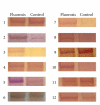Differential Expression ESTs Associated with Fluorosis in Rats Liver
- PMID: 22400010
- PMCID: PMC3286904
- DOI: 10.1155/2012/208390
Differential Expression ESTs Associated with Fluorosis in Rats Liver
Abstract
The fluoride has volcanic activity and abundantly exists in environment combining with other elements as fluoride compounds. Recent researches indicated that the molecular mechanisms of intracellular fluoride toxicity were very complex. However, the molecular mechanisms underlying the effects on gene expression of chronic fluoride-induced damage is unknown, especially the detailed regulatory process of mitochondria. In the present study, we screened the differential expression ESTs associated with fluorosis by DDRT-PCR in rat liver. We gained 8 genes, 3 new ESTs, and 1 unknown function sequence and firstly demonstrated that microsomal glutathione S-transferase 1 (MGST1), ATP synthase H(+) transporting mitochondrial F(0) complex subunit C1, selenoprotein S, mitochondrial IF1 protein, and mitochondrial succinyl-CoA synthetase alpha subunit were participated in mitochondria metabolism, functional and structural damage process caused by chronic fluorosis. This information will be very helpful for understanding the molecular mechanisms of fluorosis.
Figures


References
-
- Barbier O, Arreola-Mendoza L, Del Razo LM. Molecular mechanisms of fluoride toxicity. Chemico-Biological Interactions. 2010;188(2):319–333. - PubMed
-
- Weinstein LH, Davidson A. Fluorides in the Environment. Effects on Plants and Animals. Oxford, UK: CABI Publishing; 2004.
-
- Urbansky ET. Fate of fluorosilicate drinking water additives. Chemical Reviews. 2002;102(8):2837–2854. - PubMed
-
- Karube H, Nishitai G, Inageda K, Kurosu H, Matsuoka M. NaF activates MAPKs and induces apoptosis in odontoblast-like cells. Journal of Dental Research. 2009;88(5):461–465. - PubMed
LinkOut - more resources
Full Text Sources

